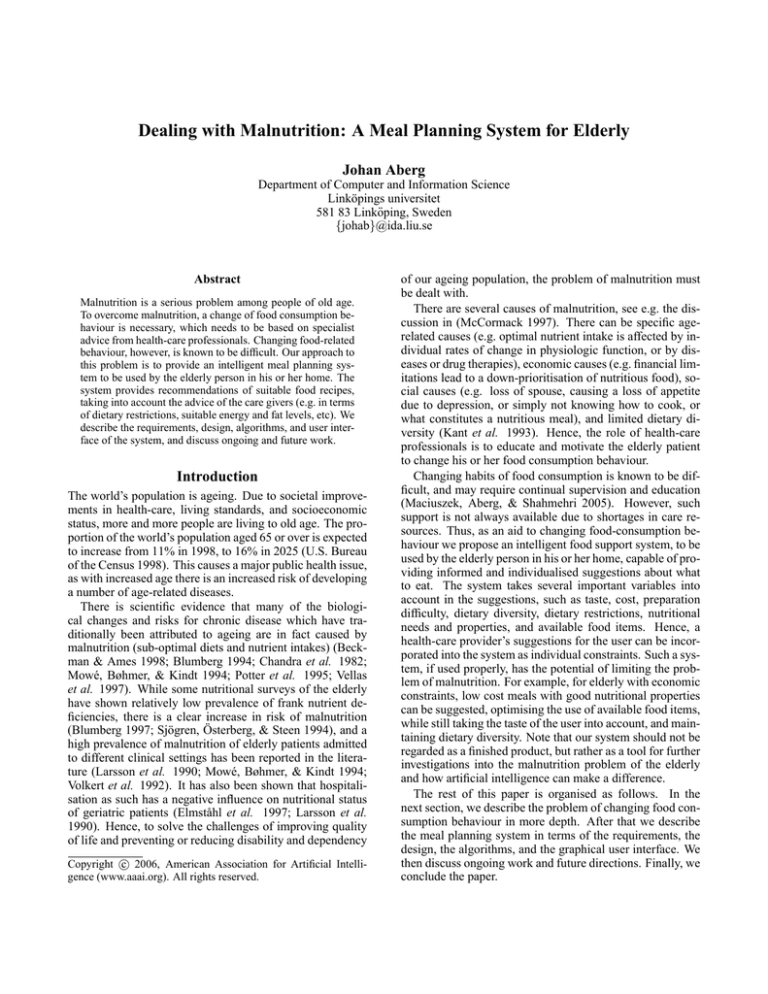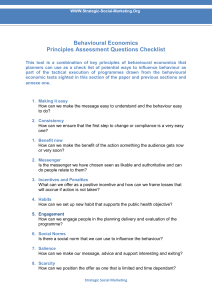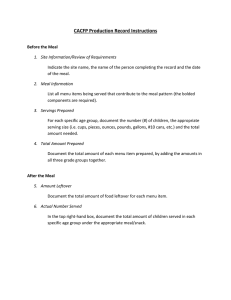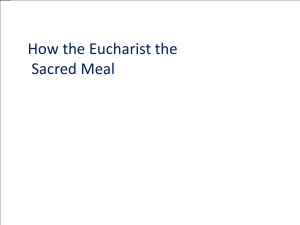
Dealing with Malnutrition: A Meal Planning System for Elderly
Johan Aberg
Department of Computer and Information Science
Linköpings universitet
581 83 Linköping, Sweden
{johab}@ida.liu.se
Abstract
Malnutrition is a serious problem among people of old age.
To overcome malnutrition, a change of food consumption behaviour is necessary, which needs to be based on specialist
advice from health-care professionals. Changing food-related
behaviour, however, is known to be difficult. Our approach to
this problem is to provide an intelligent meal planning system to be used by the elderly person in his or her home. The
system provides recommendations of suitable food recipes,
taking into account the advice of the care givers (e.g. in terms
of dietary restrictions, suitable energy and fat levels, etc). We
describe the requirements, design, algorithms, and user interface of the system, and discuss ongoing and future work.
Introduction
The world’s population is ageing. Due to societal improvements in health-care, living standards, and socioeconomic
status, more and more people are living to old age. The proportion of the world’s population aged 65 or over is expected
to increase from 11% in 1998, to 16% in 2025 (U.S. Bureau
of the Census 1998). This causes a major public health issue,
as with increased age there is an increased risk of developing
a number of age-related diseases.
There is scientific evidence that many of the biological changes and risks for chronic disease which have traditionally been attributed to ageing are in fact caused by
malnutrition (sub-optimal diets and nutrient intakes) (Beckman & Ames 1998; Blumberg 1994; Chandra et al. 1982;
Mowé, Bøhmer, & Kindt 1994; Potter et al. 1995; Vellas
et al. 1997). While some nutritional surveys of the elderly
have shown relatively low prevalence of frank nutrient deficiencies, there is a clear increase in risk of malnutrition
(Blumberg 1997; Sjögren, Österberg, & Steen 1994), and a
high prevalence of malnutrition of elderly patients admitted
to different clinical settings has been reported in the literature (Larsson et al. 1990; Mowé, Bøhmer, & Kindt 1994;
Volkert et al. 1992). It has also been shown that hospitalisation as such has a negative influence on nutritional status
of geriatric patients (Elmståhl et al. 1997; Larsson et al.
1990). Hence, to solve the challenges of improving quality
of life and preventing or reducing disability and dependency
c 2006, American Association for Artificial IntelliCopyright °
gence (www.aaai.org). All rights reserved.
of our ageing population, the problem of malnutrition must
be dealt with.
There are several causes of malnutrition, see e.g. the discussion in (McCormack 1997). There can be specific agerelated causes (e.g. optimal nutrient intake is affected by individual rates of change in physiologic function, or by diseases or drug therapies), economic causes (e.g. financial limitations lead to a down-prioritisation of nutritious food), social causes (e.g. loss of spouse, causing a loss of appetite
due to depression, or simply not knowing how to cook, or
what constitutes a nutritious meal), and limited dietary diversity (Kant et al. 1993). Hence, the role of health-care
professionals is to educate and motivate the elderly patient
to change his or her food consumption behaviour.
Changing habits of food consumption is known to be difficult, and may require continual supervision and education
(Maciuszek, Aberg, & Shahmehri 2005). However, such
support is not always available due to shortages in care resources. Thus, as an aid to changing food-consumption behaviour we propose an intelligent food support system, to be
used by the elderly person in his or her home, capable of providing informed and individualised suggestions about what
to eat. The system takes several important variables into
account in the suggestions, such as taste, cost, preparation
difficulty, dietary diversity, dietary restrictions, nutritional
needs and properties, and available food items. Hence, a
health-care provider’s suggestions for the user can be incorporated into the system as individual constraints. Such a system, if used properly, has the potential of limiting the problem of malnutrition. For example, for elderly with economic
constraints, low cost meals with good nutritional properties
can be suggested, optimising the use of available food items,
while still taking the taste of the user into account, and maintaining dietary diversity. Note that our system should not be
regarded as a finished product, but rather as a tool for further
investigations into the malnutrition problem of the elderly
and how artificial intelligence can make a difference.
The rest of this paper is organised as follows. In the
next section, we describe the problem of changing food consumption behaviour in more depth. After that we describe
the meal planning system in terms of the requirements, the
design, the algorithms, and the graphical user interface. We
then discuss ongoing work and future directions. Finally, we
conclude the paper.
A Meal Planning System
Attitude
toward the
behaviour
Subjective
norm
Intention
Behaviour
Perceived
behavioural
control
Figure 1: Theory of planned behaviour
Changing Food Consumption Behaviour
The problem of malnutrition is caused by sub-optimal eating. Hence, in order to come to terms with a malnutrition
problem, a person must change the food consumption behaviour, and eat food that better fits his or her body’s current
needs. However, changing food-related behaviours is known
to be difficult, and continual support is commonly needed.
According to one of the dominant theories in social psychology, the theory of planned behaviour (Ajzen 1991)
(which is based on the theory of reasoned action), human
behaviour is determined by specific considerations (see Figure 1). Behavioural beliefs refer to the outcome of a behaviour and the evaluation of the outcomes, and lead to an
attitude toward the behaviour. Normative beliefs refer to
the perceived expectations of others and the motivation to
live up to these expectations, and lead to a subjective norm.
Control beliefs refer to factors that can help or hinder performance of the behaviour and their relative importance, and
lead to perceived behavioural control. Together, the attitude
toward the behaviour, the subjective norm, and the perceived
behavioural control lead to a behavioural intention. Finally,
given an intention to perform a behaviour and the perceived
behavioural control, a person is expected to succeed in performing the behaviour (assuming the perceived behavioural
control is close to the actual behavioural control).
Our approach to help elderly people change their food
consumption behaviour (and thus deal with malnutrition
problems), is to provide them with a tool for meal planning to be used in their homes1 . Connecting to the theory of
planned behaviour, we expect this would raise the perceived
behavioural control of the users2 , in the sense that they feel
that they have all the knowledge and resources needed for
actually changing their behaviour and prepare and consume
meals suitable for them. This meal planning system is described next.
1
This obviously raises questions of whether the users would be
able and willing to use the system. See our discussion on user
studies below.
2
Our focus on increasing a user’s perceived behavioural control
does not mean that we neglect the other factors influencing intention and behaviour, it simply means that we must start somewhere.
Our approach to helping users change their food consumption behaviour is a system that recommends meal plans. As
such, our system is a recommender system, which is a class
of decision aids, where the aim is to provide users with individualised recommendations on objects from some particular domain (Montaner, Lopez, & de la Rosa 2003). Recommender systems have so far been of great importance for
e-commerce (Schafer, Konstan, & Riedl 2001), and also of
value for other important tasks such as information search on
the Internet (Montaner, Lopez, & de la Rosa 2003). However, to the best of our knowledge, our system is the first
recommender system to be applied to a health care problem.
Requirements
The factors influencing a person’s food choice have been
studied to a fairly large extent in the science of food and
nutrition. Shepherd (Shepherd 1989) described several attempts to identify factors influencing food choice, and went
on to propose the use of the theory of reasoned action as a
general model for food choice. However, this model is completely based on user’s attitudes, and does not seem suitable
as a normative framework. After all, we are not really interested in predicting a user’s food choice, but to persuade
the user of choosing optimal food, weighing in the relevant
factors. Hence, we have taken the approach of gathering
the most feasible3 factors from all the models presented in
(Shepherd 1989). This means that our system is required to
represent and reason about the following information:
• Dietary restrictions, e.g. ingredients that the user is allergic to, or must not eat for other medical reasons.
• Nutritional values, e.g. amount of fat or protein contained
in a recipe, or required by a user.
• Preparation time of a meal.
• Preparation difficulty of a meal.
• Cost of a meal, i.e. the cost of the needed ingredients.
• Availability of ingredients for a meal, e.g. to what extent
does the needed ingredients match the ingredients available to the user at home.
• Variation with respect to other meals in the plan, in terms
of used ingredients and the category of a meal.
• The user’s food taste, i.e. how the user rates a recipe on a
taste scale.
Design
To be able to take these requirements into account, the system has a hybrid design in the sense that it makes use of
both collaborative filtering and a content-based approach.
The collaborative filtering is used for predicting a user’s
taste opinion of a certain recipe that he or she has not yet
rated, based on the user’s other ratings and the ratings of
other users. For the content-based approach we make use of
3
By feasible we mean that a factor should be feasible to make
use of in the system, with respect to practical knowledge engineering and reasoning issues.
a specially designed XML-based mark-up language for food
recipes, that allow us to represent the needed content information for the recipes in the database4 . Our approach to construct optimal meal plans according to the factors presented
above uses constraint satisfaction techniques. More details
on the algorithms employed in our meal planning system are
provided next.
Algorithms
We model the constraint-satisfaction problem with a mix of
weighted soft constraints and traditional hard constraints,
similar to the approach in (Torrens 2002). We have experimented with two different ways of modelling the problem.
In our parameter-based approach, variables are used for the
parameters of a recipe, such as time, cost, energy, protein,
etc, and the variable domains are based on the existing values in the recipe database. There is also a special hard constraint requiring a complete variable assignment to match
only existing recipes in the database. The other, recipebased, model is simpler, and has only one variable per meal
in the plan, with the set of recipes as value domain.
For both models, we employ a set of additional constraints
to take the user’s needs and preferences into account. Such
constraints include hard constraints, e.g. for ingredients to
avoid, and soft constraints, e.g. for variation between meals
(a recipe with many ingredients in common with a recipe for
a previous meal gets a penalty) and for taste (recipes with
high rating or predicted rating get low penalty). A collaborative filtering approach is used to predict ratings for unrated
recipes. We have implemented a version of the item-based
algorithm (Sarwar et al. 2001), with adjusted cosine similarity, and weighted sum predictions.
For solving the constraint-satisfaction problem we base
our approach on the well-known depth-first branch and
bound algorithm. We have also been experimenting with
a set of forward-checking approaches and variable ordering heuristics. Our current implementation uses depth-first
branch and bound with partial forward checking.
User Interface
The user interface of the system has been designed particularly for elderly users. The current user interface design
is the result of an in-depth exploration of the design space
(by means of the QOC framework (MacLean et al. 1991)),
taking existing literature on universal access and user interface design for elderly into account as evaluation criteria for
the explored design options. Two separate prototype designs
were created as paper prototypes and evaluated empirically
with elderly users. Based on these user studies the current
user interface was designed and implemented, in an attempt
to use the best features from each of the two earlier prototypes. Figure 25 shows a part of the settings management,
4
We have also developed a semi-automatic tool to facilitate the
extraction of information from food recipes in text format.
5
The user interface is designed in Swedish, so some additional
explanations may be needed for most readers of this paper. The
menu to the left is used for reaching different settings pages. In
this screen shot we are at the settings for the time period (“Tidspe-
where a user can select the time period for which the system
will recommend meals. Note that this is just a part of the
settings that a user can perform. Among other things, a user
can also select required intervals for energy, fat, cholesterol,
etc. Such settings are absolutely crucial for our purpose of
helping elderly people avoid malnutrition, and the actual settings should be done in collaboration with the user’s care
givers. The user can also select ingredients to avoid, select
preference levels for cost, preparation time, etc, and mark
ingredients as currently available.
Figure 36 shows an example of a recommended meal plan
for a certain time period. Note that the user can switch between the top-5 meal plans, and give taste ratings on suggested recipes (on a scale from 1 to 5) and re-plan to take
the new ratings into account, or create special settings for a
certain meal, such as allowing a greater cost and preparation
time for the Sunday meal.
Ongoing Work
Algorithms
In our ongoing work, we are investigating the trade-offs
for the two constraint-satisfaction models we have implemented. The main aspect we are looking into is the computation time required for solving the constraint-satisfaction
problem. Based on our two alternative constraint models of
the meal planning problem, we are experimenting with the
following parameters:
• Number of recipes in the database.
• Number of meals in the requested plan (e.g. the length of
the time period).
• The number of users to plan for (e.g. the size of the family,
or the number of persons in the assisted living facility).
Based on a set of 50 real food recipes and a much larger
set of randomly generated recipes (the random generation
is based on parameters from the real recipes) we have conducted several simulation experiments. So far, the results
indicate that the two models have complementary characteristics. The parameter-based model performs very well
with small recipe collections and can make plans for several meals with just a few seconds response time. However, this model only provides reasonable response times for
data sets of a maximum of roughly 500 recipes. The recipebased model on the other hand scales well with increasing
riod”). The area to the right of the calendar shows the user’s current
calendar choices as additional feedback. The rightmost area of the
screen contains a help text for this particular settings page. This
help text can be toggled on and off, but is on by default.
6
This screen shot illustrates the meal plan menu generated by
the system. Currently the first, and best, alternative is displayed.
The user can toggle between different alternatives with the topmost buttons. Note that the recipe names are shown in English in
this example. To the right of each recipe name is a slider for changing the taste rating, and to the right of this slider is the current rating, written in text. In this example all recipes have previously been
rated by the user, so no predicted ratings are displayed. Above the
area for the recommended recipes are buttons for changing settings
and for replanning based on new taste ratings.
Figure 2: Meal planning system settings: selecting the time period for the meal plan
recipe collections, but is limited with respect to the number
of meals to plan for.
User Studies
As discussed previously, our main aim with the meal planning system is to put the elderly person in charge of changing his or her food consumption behaviour. By providing
the user with recommendations of suitable recipes that take
into account important parameters such as dietary restrictions, cost, and the preparation skills of the user, we hope to
increase the user’s behavioural control, which is critical for
changing behaviour. However, it is of course a prerequisite
that the user accepts the system and really uses it. Although
the user interface has been designed based on user studies of
paper prototypes involving potential future users, an important question is whether the implemented system is usable
and acceptable for elderly users. To answer this question
we are currently conducting a user study with several older
adults. In the study, after a very brief oral description of the
system, the users are assigned a set of tasks to be solved with
the system. At the time of writing we have data from four
users (with age ranging from 70 to 82, and with varying degrees of previous computer experience). Our observations
and interviews have highlighted several problems with the
current interface that will need to be adressed in the next
version. However, and more importantly, after having gone
through all the test tasks, all four users have been able to
use all the main functions of the system, despite minor flaws
and initial orientation problems. This is an important result,
illustrating the potential of the system.
Future Directions
Faster Algorithms
Given the preliminary results reported on earlier, there is
a clear need to further investigate means to speed up meal
planning algorithms. Ideally we would like the system to be
able to make plans for at least a week at the time, and with
large databases containing up to 10,000 recipes. Even if our
system is working well with our current small databases, we
are not there yet, and we won’t be there in a few years either if we extrapolate using Moore’s law. Hence, we plan
to continue our efforts to improve the algorithms and the
constraint models. As a starting point we intend to examine
how the complementing characteristics of the two present
constraint models can be exploited. We will also explore
the possibilities of terminating the search before the whole
search tree has been explored. The rationale for this approach comes from our empirical results showing that the
time spent searching for the last few complete assignments
make up the great majority of the total time spent on the
search, while the reduction in upper bound that these last as-
Figure 3: Meal planning system output: a recommended meal plan
signments bring is fairly small. The important question to
be answered is of course whether such pre-termination, and
the resulting non-optimal plan, would have a negative effect
on users’ acceptance of the system.
Explanation Facilities
We are looking into explanation facilities as a means of improving the system’s acceptability. One of the main features
of explanation facilities is to make the performance of the
system transparent to the users. System explanations can
provide information about the knowledge that the system
has, and how it reasons. Explanations can also serve as justifications for advice provided by the system. In the context of
advice-giving systems, explanations are of most importance
for users when they perceive an anomaly (such as a recommendation that they disagree with), or when they want to
learn about the system (Gregor & Benbasat 1999).
Explanations can be categorised according to three dimensions (Gregor & Benbasat 1999): 1) the content of
the explanations, 2) the provision mechanism, and 3) the
presentation format. The content of explanations can in
turn be divided into four types. The first type is called
trace (or line of reasoning). Trace explanations explain
why decisions were made by describing the steps taken to
reach the decision. The second type is called justification
(or support). Justification explanations attempt to justify
each step in the system’s reasoning, by connecting it to
“deep” knowledge from which the reasoning was derived.
The third type of explanation is called control (or strategic). Control explanations aim at explaining the system’s
control behaviour and problem solving strategy. Finally,
the fourth explanation type is called terminological. The
aim is to provide terminological information, such as definitions of terms used by the system. There is empirical
support indicating that justification and terminological explanations are particularly useful (Gregor & Benbasat 1999;
Ye & Johnson 1995).
As for the provision mechanism, explanations can be
user-invoked (provided at the request of the user), automatic (always presented to the user, possibly with extensions
within reach with a hypertext click), or intelligent (explanations provided only when the system considers they are
needed). Existing theory suggests that the less cognitive effort required to access and absorb an explanation, the more
used and effective they will be (Gregor & Benbasat 1999).
This clearly speaks for automatic or intelligent provision
mechanisms. The advantage of automatic explanations over
user-invoked ones has also been demonstrated empirically
(Moffitt 1994). It has also been shown that case-specific
explanations are more effective than generic explanations
(Berry & Broadbent 1987).
Explanations can be presented in different text-based for-
mats, such as rules of the system in some kind of pseudo
code, “canned text” versions of such rules, or in generated
natural language. There are also possibilities for using multimedia, with graphics, animation, or voice. There is currently little evidence as for what kind of presentation format
should be preferred. However, general usability principles
must be adhered to.
To summarise, we can conclude that for explanations to be
used and useful they have to be provided automatically (or
intelligently), be of justification type, and be case specific.
Also, the existing terminology in the system should be explained. Finally, we note the importance of tailoring the presentation to the user’s preferences (Carenini & Moore 2001;
Grasso, Cawsey, & Jones 2000). This will be the starting
point for our work on exploring different kinds of explanation facilities for the meal planning system, and their relation
to users’ acceptance of the system, as well as their potential
for educating the user about healthy eating.
Conclusions
We have presented a new approach to meal planning, aiming
at helping elderly people deal with malnutrition problems by
increasing their behavioural control. This work is part of the
Virtual Companion project at Linköping university (Shahmehri et al. 2004). The approach should be regarded as a
novel AI-based approach to the problem, and represents the
first steps in a larger project. Hence, the implementation described in this paper should be regarded as a tool for future
research and studies, and not as a finished product.
The meal planner in its current form mainly attempts to
help the users change their food consumption behaviours by
influencing their perceived behavioural control. However,
by also including persuasive features in the system we could
influence the users’ attitudes toward their behaviour as well.
The explanation facilities we have discussed could be regarded as persuasive features, but other approaches should
also be explored. Such approaches could range from the
simple (e.g. having a traffic light symbol indicating healthy
settings with a green light and unhealthy settings with a red
light), to the complex (e.g. transforming a scanned photo of
the user into a relaxed smile when the settings are good, and
into an angry and tired look when the settings are bad).
Although the system presented here has been focused on
individual users, the underlying techniques could very well
be used for different purposes, for example supporting the
meal planning of a hospital or a retirement home. In fact,
the system already has support for dealing with multiple user
profiles, e.g. several members of a family or dinner guests.
Finally, even if our proposed system is targeted at the
elderly population where the problem of malnutrition is of
greatest concern, it could as well be of use for the younger
population. In stressed situations, it is easy to resort to well
remembered meals that have been frequently cooked in the
recent past, and thus sacrificing dietary diversity. Having access (possibly mobile) to suggestions provided by our system could thus make the life easier for many people, not
necessarily of old age.
Acknowledgements
This research has been partly supported by the Swedish
Council for Working Life and Social Research. Thanks to
Kajsa Lindén for her work on the implementation of the user
interface, and to Niclas Sundmark for his work on the implementation of the meal planning algorithms. The ongoing
user study is done in collaboration with Birgitta Lorefält at
the Department of Medicine and Care, Division of Nursing
Science, Faculty of Health Sciences, Linköping University.
References
Ajzen, I. 1991. The Theory of Planned Behavior. Organizational Behavior and Human Decision Processes 50:179–
211.
Beckman, K. B., and Ames, B. N. 1998. The Free Radical Theory of Ageing Matures. Physiological Reviews
78(2):547–581.
Berry, D. C., and Broadbent, D. E. 1987. Explanation
and Verbalization in a Computer-assisted Search Task. The
Quarterly Journal of Experimental Psychology 39A:585–
609.
Blumberg, J. B. 1994. Nutrient Requirements of the
Healthy Elderly – Should There Be Specific RDAs? Nutrition Reviews 52(8):515–518.
Blumberg, J. 1997. Nutritional Needs of Seniors. Journal
of the American College of Nutrition 16(6):517–523.
Carenini, G., and Moore, J. D. 2001. An Empirical Study
of the Influence of User Tailoring on Evaluative Argument
Effectiveness. In Proceedings of the 17th International
Joint Conference on Artificial Intelligence (IJCAI 2001),
1307–1314.
Chandra, R.; Joshi, P.; Au, B.; Woodford, G.; and Chandra, S. 1982. Nutrition and immunocompetence of the elderly: effect of short-term nutritional supplementation on
cellmediated immunity and lymphocyte subsets. Nutrition
Reseach 2:223–232.
Elmståhl, S.; Persson, M.; Andren, M.; and Blabolil, V.
1997. Malnutrition in geriatric patients: a neglected problem? Journal of Advanced Nursing 26:851–855.
Grasso, F.; Cawsey, A.; and Jones, R. 2000. Dialectical
argumentation to solve conflicts in advice giving: a case
study in the promotion of healthy nutrition. International
Journal of Human-Computer Studies 53:1077–1115.
Gregor, S., and Benbasat, I. 1999. Explanations From
Intelligent Systems: Theoretical Foundations and Implications for Practice. MIS Quarterly 23(4):497–530.
Kant, A. K.; Schatzkin, A.; Harris, T. B.; Ziegler, R. G.;
and Block, G. 1993. Dietary diversity and subsequent
mortality in the First National Health and Nutrition Examination Survey Epidemological Follow-up Study. American
Journal of Clinical Nutrition 57:434–440.
Larsson, J.; Unosson, M.; Ek, A.-C.; Nilsson, S.;
Thorslund, S.; and Bjurulf, P. 1990. Effect of Dietary
Supplement on Nutritional Status and Clinical Outcome in
501 Geriatric Patients – a Randomised Study. Clinical Nutrition 9:179–184.
MacLean, A.; Young, R. M.; Bellotti, V. M. E.; and Moran,
T. P. 1991. Questions, Options, and Criteria: Elements
of Design Space Analysis. Human-Computer Interaction
6(3&4):201–250.
Maciuszek, D.; Aberg, J.; and Shahmehri, N. 2005. What
Help Do Older People Need? Constructing a Functional
Design Space of Electronic Assistive Technology Applications. In Proceedings of the Seventh International ACM
SIGACCESS Conference on Computers and Accessibility
(ASSETS’2005), 4–11.
McCormack, P. 1997. Undernutrition in the elderly population living at home in the community: a review of the
literature. Journal of Advanced Nursing 26:856–863.
Moffitt, K. 1994. An Analysis of the Pedagogical Effects
of Expert System Use in the Classroom. Decision Sciences
25(3):445–460.
Montaner, M.; Lopez, B.; and de la Rosa, J. L. 2003. A
taxonomy of recommender agents on the internet. Artificial
Intelligence Review 19:285–330.
Mowé, M.; Bøhmer, T.; and Kindt, E. 1994. Reduced nutritional status in an elderly population (> 70 y) is probable
before disease and possibly contributes to the development
of disease. American Journal of Clinical Nutrition 59:317–
324.
Potter, J.; Klipstein, K.; Reilly, J. J.; and Roberts, M. 1995.
The Nutritional Status and Clinical Course of Acute Admissions to a Geriatric Unit. Age and Ageing 24:131–136.
Sarwar, B.; Karypis, G.; Konstan, J.; and Riedl, J. 2001.
Item-Based Collaborative Filtering Recommendation Algorithms. In Proceedings of the 10th International World
Wide Web Conference (WWW10), 285–295.
Schafer, J. B.; Konstan, J. A.; and Riedl, J. 2001. ECommerce Recommendation Applications. Journal of
Data Mining and Knowledge Discovery 5(1/2):115–152.
Shahmehri, N.; Aberg, J.; Maciuszek, D.; and Chisalita, I.
2004. Linköping University’s Virtual Companion Project.
IEEE Pervasive Computing 3(2):50.
Shepherd, R. 1989. Factors Influencing Food Preferences
and Choice. In Shepherd, R., ed., Handbook of the Psychophysiology of Human Eating. John Wiley and Sons.
chapter 1, 3–24.
Sjögren, A.; Österberg, T.; and Steen, B. 1994. Intake
of Energy, Nutrients and Food Items in a Ten-year Cohort
Comparison and in a Six-year Longitudinal Perspective: A
Population Study of 70- and 76-year-old Swedish People.
Age and Ageing 23:108–112.
Torrens, M. 2002. Scalable Intelligent Electronic Catalogs.
Phd. thesis no. 2690, Swiss Federal Institute of Technology
(EPFL), Lausanne, Switzerland.
U.S. Bureau of the Census. 1998. World population profile:
1998. Technical Report WP/98, US Government Printing
Office, Washington DC.
Vellas, B. J.; Hunt, W. C.; Romero, L. J.; Koehler, K. M.;
Baumgartner, R. N.; and Garry, P. J. 1997. Changes in
Nutritional Status and Patterns of Morbidity Among Free-
Living Elderly Persons: A 10-Year Longitudinal Study.
Nutrition 13(6):515–519.
Volkert, D.; Kruse, W.; Oster, P.; and Schlierf, G. 1992.
Malnutrition in geriatric patients: diagnostic and prognostic significance of nutritional parameters. Annals of Nutrition Metabolism 36:97–112.
Ye, L. R., and Johnson, P. E. 1995. The Impact of Explanation Facilities on User Acceptance of Expert System
Advice. MIS Quarterly 19(2):157–172.






